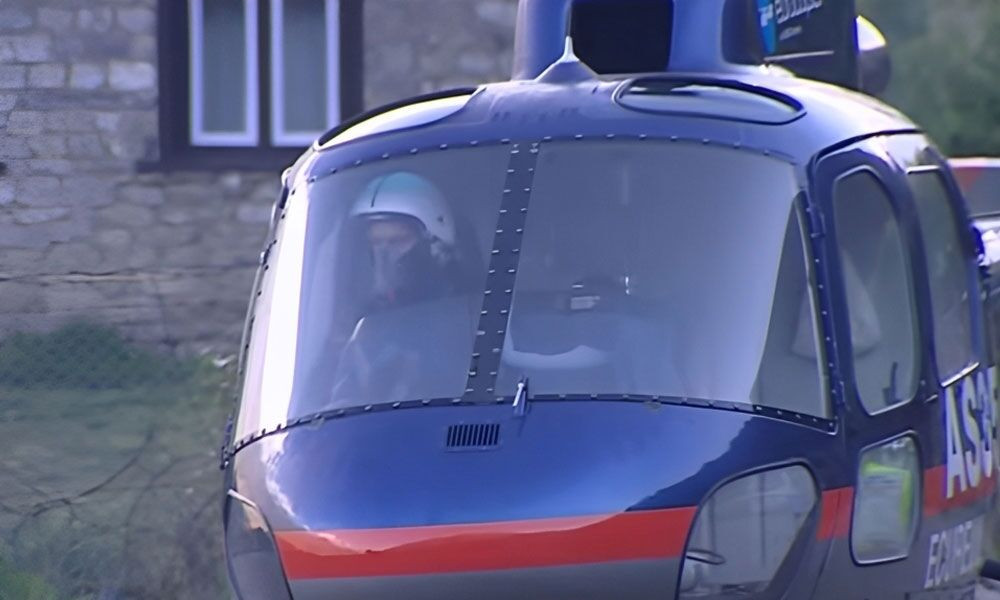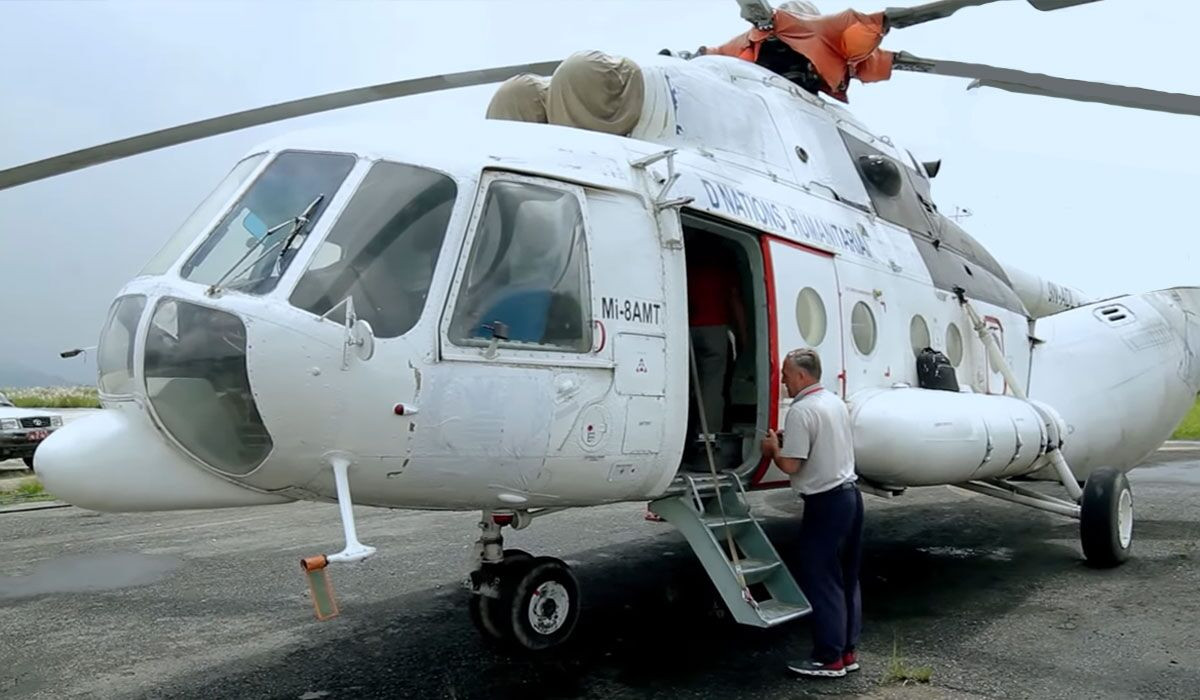Can A Helicopter Fly Over Everest? The short answer is generally no, but there’s more to the story. This article from flyermedia.net delves into the factors limiting helicopter flights to the summit of Mount Everest and explores alternative ways to experience the majestic Himalayas by air, focusing on flight training, aviation news, and aviation career opportunities. Discover more about flight performance and aviation technology.
1. The Legend Who Touched Down on Everest
Before we dive into the technicalities of “can a helicopter fly over the top of Mount Everest,” let’s talk about Didier Delsalle, a French pilot who achieved the seemingly impossible. On May 14, 2005, Delsalle landed his Eurocopter AS350 B3 on the summit of Everest, a feat that remains unmatched. He was a former French Air Force fighter pilot (1979) and a helicopter pilot who served for a decade in search and rescue operations.
1.1 Delsalle’s Unimaginable Feat
Delsalle’s success was not just a matter of skill; it involved meticulous planning and a specially modified helicopter. However, his flight remains a singular event, highlighting the extreme challenges involved. The project was given the go-ahead in 2004, when a new version of the Turbomeca Arriel 2 outperformed its predecessor. He stayed on the summit of Mt. Everest for 3 minutes and 50 seconds before flying down to Lukla.
 Eurocopter-AS350-Écureuil-Squirrel-helicopter-Didier-Delsalle
Eurocopter-AS350-Écureuil-Squirrel-helicopter-Didier-Delsalle
2. Failed Attempts After Delsalle
While Delsalle proved it could be done, the risks and difficulties are immense.
| Year | Name of Pilot | Helicopter Model |
|---|---|---|
| 2005 | Lt. Col. Madan Khatri Chhetri | Eurocopter AS350 B3 (modified for high-altitude flying) |
| 2007 | Gerold Biner | Eurocopter AS350 B3 (with special engine and rotor blades) |
| 2013 | Alexey Gusev | Eurocopter AS350 B3 (special engine and rodor blades) |
3. What Challenges Prevent Helicopters from Flying to the Summit?
Several factors combine to make routine helicopter flights to Everest’s peak nearly impossible. These range from air pressure and weather to technical limitations and the extreme altitude.
3.1 Air Pressure and Density
Helicopters rely on air density to generate lift. At Everest’s summit, the air is incredibly thin, providing less resistance for the rotor blades.
- Reduced Efficiency: Thin air decreases the rotor system’s efficiency, making it difficult to maintain altitude and maneuverability.
- Cold Temperatures: Cold temperatures affect rotor blade flexibility, further reducing aerodynamic performance.
3.2 Unpredictable Weather Patterns
The Himalayas are known for their rapidly changing and often extreme weather.
- High Winds and Blizzards: These conditions cause turbulence and instability, making flight dangerous.
- Limited Stable Seasons: Spring (March to May) and autumn (September to November) offer the most stable weather, but conditions can still change rapidly.
3.3 Technical Limitations
Even with modifications, helicopters face technical challenges at extreme altitudes.
- Pilot Miscalculation: Variations in air pressure and weather demand constant adjustments. A single miscalculation can be fatal.
- Cold Weather Effects: Cold temperatures can impact battery life and freeze fuel, compromising the helicopter’s performance.
3.4 Difficult Terrain for Landing
The summit of Everest offers very little space for a safe landing.
- Steep Slopes: The ice and snow slopes tilt at approximately 40 degrees, making landing precarious.
- Limited Space: The small area available limits landing time and increases the risk of sliding or rolling over.
3.5 The Death Zone
Mount Everest includes a significant portion of the “death zone,” where oxygen levels are critically low.
- Low Oxygen Saturation: Oxygen saturation drops to around 34%, affecting engine performance and putting the crew at risk of altitude sickness and hypoxia.
- Health Risks: Exposure to the death zone can cause rapid cell death, posing a severe threat to the crew’s health.
 Can a helicopter fly to Everest
Can a helicopter fly to Everest
4. What Is the Highest Landing Point on Everest?
While summit landings are rare, helicopters play a crucial role in rescue operations. The highest reliable landing point is Camp II, at 6,400 meters (20,997 feet).
4.1 Camp II: The Primary Evacuation Point
Camp II provides relatively flat terrain suitable for helicopter landings, making it the primary location for evacuations. Camp I, at 6,065 meters (19,900 feet), is also used in emergencies but offers less space.
4.2 Limits of Rescue Operations
Above Camp II, rescue operations are limited to rope-based extractions due to the lack of stable landing spots. Commercial flights to the summit remain impossible due to these constraints.
5. How High Can Helicopters Fly Up Everest?
Standard helicopters typically operate at altitudes of around 3,000 meters (10,000 feet). For flights in the Everest region, turbine helicopters capable of reaching up to 7,200 meters (23,622 feet) are used. Even if reaching the summit isn’t feasible, you can still capture stunning views of the mountain from a distance.
6. Alternative Ways to See Everest by Helicopter
While flying to the top of Everest remains elusive, several incredible helicopter tour options provide breathtaking aerial views of the region.
6.1 Everest Base Camp Helicopter Tour
This one-day tour offers a flight over the major highlights of the Everest region, including Everest Base Camp (5,364 meters) and Kalapatthar (5,644 meters).
- Typical Itinerary: Flight from Kathmandu (1,400 meters) to Lukla (2,800 meters), followed by a shuttle to Pheriche (4,371 meters) and flights over Base Camp and Kalapatthar.
- Flight Duration: The flight over the base camp lasts about 15 to 20 minutes, offering excellent views for all passengers.
6.2 Everest Base Camp Private Helicopter Tour
For a more immersive experience, consider a private tour that includes a landing at Kalapatthar, the highest and most popular viewpoint in the region.
- Exclusive Experience: Land at Kalapatthar and spend 15 to 20 minutes admiring the grandeur of Everest and the surrounding mountains up close.
6.3 Everest Base Camp Heli Trek
Combine trekking with an aerial adventure on this tour. Trek to Everest Base Camp and then take a helicopter flight back to Kathmandu from Gorak Shep (5,164 meters).
- Trekking Route: Ascend from Phakding (2,652 meters), cross highlights like Namche Bazaar (3,440 meters), Tengboche (3,868 meters), Dingboche (4,410 meters), and Lobuche (4,910 meters), and reach Everest Base Camp via Gorak Shep.
- Helicopter Return: Enjoy panoramic views of the Himalayas during the flight back to Kathmandu, skipping the return trek.
7. Exploring Flight Training and Aviation Careers with Flyermedia.net
Are you passionate about aviation and dreaming of a career in the skies? Flyermedia.net is your go-to resource for flight training, aviation news, and exciting career opportunities in the USA. Whether you’re seeking pilot training schools or the latest industry updates, we’ve got you covered.
7.1 Find Reputable Flight Training Schools
Choosing the right flight school is the first step toward a successful aviation career. Flyermedia.net offers a comprehensive list and reviews of top-rated flight training schools in the United States.
- Daytona Beach, Florida: Known as an aviation hub, Daytona Beach is home to several prestigious flight schools, offering top-notch pilot training programs.
7.2 Stay Updated with Aviation News
Keep your finger on the pulse of the aviation industry with our regularly updated news section. From technological advancements to regulatory changes, we deliver the information you need to stay informed.
- FAA Regulations: Stay compliant with the latest FAA regulations and guidelines, ensuring your aviation practices are safe and legal.
7.3 Discover Aviation Career Opportunities
Looking for your dream job in aviation? Flyermedia.net lists a wide range of job opportunities, from pilot positions to aircraft maintenance and engineering roles.
- Pilot Careers: Explore opportunities with major airlines, cargo carriers, and private aviation companies.
- Engineering and Maintenance: Find roles in aircraft design, manufacturing, and maintenance, contributing to the safety and efficiency of air travel.
7.4 Connecting Passionate Aviation Professionals
We are dedicated to connecting passionate individuals with the resources they need to thrive in the aviation industry. Whether you’re an aspiring pilot, an experienced engineer, or simply an aviation enthusiast, flyermedia.net is your ultimate resource.
8. Conclusion: The Future of Everest Flights
While reaching Everest’s summit by helicopter remains a significant challenge, technological advancements may one day make it feasible. For now, helicopter tours offer an incredible way to experience the beauty of the Himalayas from above.
8.1 Call to Action
Ready to explore the world of aviation? Visit flyermedia.net today to discover flight training options, stay updated on aviation news, and find exciting career opportunities in the USA. Your adventure in the skies awaits.
Address: 600 S Clyde Morris Blvd, Daytona Beach, FL 32114, United States
Phone: +1 (386) 226-6000
Website: flyermedia.net
9. FAQ: Helicopters and Everest
9.1 Is it currently possible for commercial helicopters to land on the summit of Mount Everest?
No, commercial helicopter landings on the summit of Mount Everest are not currently possible due to air pressure, weather conditions, technical limitations, difficult terrain, and altitude constraints.
9.2 Who was the first person to land a helicopter on Mount Everest?
Didier Delsalle, a French pilot, was the first person to successfully land a helicopter on the summit of Mount Everest on May 14, 2005.
9.3 What type of helicopter did Didier Delsalle use for his Everest landing?
Delsalle used a Eurocopter AS350 B3, which was specially modified for high-altitude flying.
9.4 What is the highest altitude a helicopter can typically reach on Everest for rescue operations?
Helicopters can reach a maximum altitude of 6,400 meters (20,997 feet), which is Camp II during the Everest expedition, for rescue operations.
9.5 What are the primary challenges that prevent helicopters from flying to the top of Mount Everest?
The primary challenges include thin air, unpredictable weather, technical errors, difficult terrain for landing, and the low oxygen saturation in the death zone.
9.6 What is the Everest Base Camp Helicopter Tour?
The Everest Base Camp Helicopter Tour is a one-day exploration of the Everest region that flies over major highlights, including Everest Base Camp and Kalapatthar.
9.7 What is unique about the Everest Base Camp Private Helicopter Tour?
The Everest Base Camp Private Helicopter Tour allows you to land at Kalapatthar, providing an opportunity to explore the area on foot and admire the mountains up close.
9.8 How does the Everest Base Camp Heli Trek combine trekking and aerial adventure?
The Everest Base Camp Heli Trek involves trekking to Everest Base Camp and then taking a helicopter flight back to Kathmandu from Gorak Shep.
9.9 What altitude do turbine helicopters typically reach during tours in the Everest region?
Turbine helicopters used for tours in the Everest region can typically reach altitudes of up to 7,200 meters (23,622 feet).
9.10 What is the death zone, and how does it affect helicopter flights near Everest?
The death zone is a segment on Everest above 8,000 meters with extremely low oxygen levels, affecting engine performance and putting the crew at risk of altitude sickness and hypoxia, making helicopter flights to the summit dangerous.
